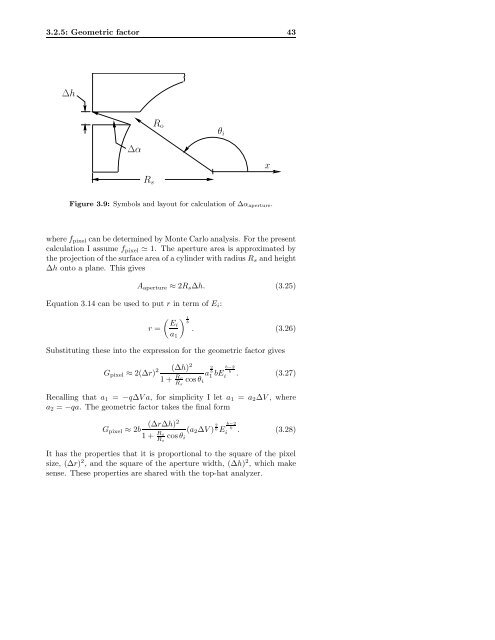PhD thesis - Institute for Space Research - University of Calgary
PhD thesis - Institute for Space Research - University of Calgary
PhD thesis - Institute for Space Research - University of Calgary
You also want an ePaper? Increase the reach of your titles
YUMPU automatically turns print PDFs into web optimized ePapers that Google loves.
3.2.5: Geometric factor 43<br />
∆h<br />
∆α<br />
R s<br />
R o<br />
θ i<br />
x<br />
Figure 3.9: Symbols and layout <strong>for</strong> calculation <strong>of</strong> ∆α aperture.<br />
where f pixel can be determined by Monte Carlo analysis. For the present<br />
calculation I assume f pixel ≃ 1. The aperture area is approximated by<br />
the projection <strong>of</strong> the surface area <strong>of</strong> a cylinder with radius R s and height<br />
∆h onto a plane. This gives<br />
A aperture ≈ 2R s ∆h. (3.25)<br />
Equation 3.14 can be used to put r in term <strong>of</strong> E i :<br />
r =<br />
( ) 1<br />
Ei b<br />
. (3.26)<br />
a 1<br />
Substituting these into the expression <strong>for</strong> the geometric factor gives<br />
G pixel ≈ 2(∆r) 2 (∆h) 2<br />
a 2 b<br />
1 + Ro 1 bE b−2<br />
b<br />
i . (3.27)<br />
R s<br />
cos θ i<br />
Recalling that a 1 = −q∆V a, <strong>for</strong> simplicity I let a 1 = a 2 ∆V , where<br />
a 2 = −qa. The geometric factor takes the final <strong>for</strong>m<br />
G pixel ≈ 2b<br />
(∆r∆h)2 (a 2 ∆V ) 2 b−2<br />
b E<br />
b<br />
1 + Ro<br />
i . (3.28)<br />
R s<br />
cos θ i<br />
It has the properties that it is proportional to the square <strong>of</strong> the pixel<br />
size, (∆r) 2 , and the square <strong>of</strong> the aperture width, (∆h) 2 , which make<br />
sense. These properties are shared with the top-hat analyzer.


